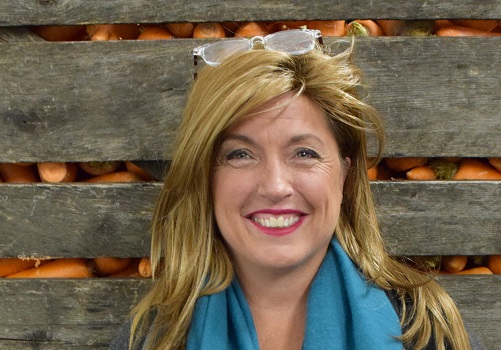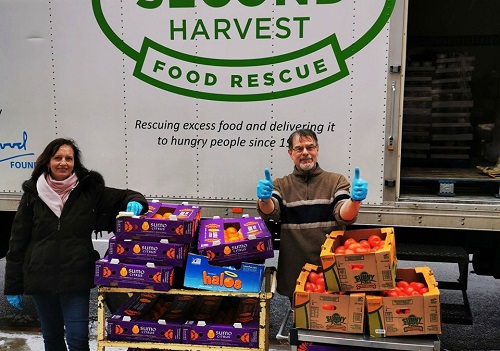The largest food rescue organization in Canada, Second Harvest works across the supply chain from farm to retail to capture surplus food before it winds up in landfill. With a fleet of 11 trucks and their online platform FoodRescue.ca, Second Harvest has rescued and redistributed 15.6 million pounds of fresh, healthy food to more than 1,000 non-profit partners across Canada.
And they’re not about to slow down due to the current COVID-19 crisis. On the contrary, they’re stepping up their efforts big time. The food recovery and redistribution leader has developed the Food Rescue Canadian Alliance (FRCA), an initiative that is bringing together government, private and non-profit sectors to ensure food reaches the most vulnerable members of our communities, from coast-to-coast.
We spoke with Second Harvest CEO, Lori Nikkel, to learn more about the initiative and how, through collaboration, community engagement and hard work, they’re making food available to organizations and reaching populations that are in acute need.
Tell us briefly about Second Harvest and its mission
Second Harvest started in 1985 with two friends rescuing leftover restaurant meals, loading them into a hatchback and dropping them off at shelters. Our mission is, No Waste, No Hunger, and Second Harvest’s DNA of food recovery and redistribution has stayed the same, despite 35 years of growth and change. We now rescue millions of pounds of surplus food every year from across the supply chain; we have a fleet of refrigerated trucks; we serve hundreds of social service agencies; and we launched a community-based, online food donation platform that’s now operating across Canada. We rescue unsold surplus food that would have otherwise gone to landfill: last year we rescued 15.6 million pounds – but research shows that there are about 11.2 million metric tonnes of potentially rescuable food lost and wasted in the Canadian food supply chain every year.
What prompted you to launch the Food Rescue Canadian Alliance (FRCA) Task Force?
Several pieces came together. First, Second Harvest did a research project this winter which mapped non-profits across Canada, specifically the ones that use food as part of their programs. We found that there are more than 60,000 – that’s a lot of diverse programs that could benefit from having access to surplus food to support their communities.
Our research is solution-focused and what seemed obvious was that these 60,000 non-profits would benefit from being able to connect directly to food donors. We’d already developed FoodRescue.ca, our online food donation platform, and expanding its reach to potential food donors and non-profits was a logical next step. Second Harvest has decades-strong connections across the food industry, the non-profit sector and government so we created an alliance of local, provincial and national partners to promote food rescue. But within weeks, the COVID-19 crisis has caused the alliance to shift gears to support a national emergency food response.
How does it work?
Our focus is to get food donors and non-profits across Canada to register on FoodRescue.ca so they can start the recovery and redistribution of food. We are sharing information across our network of non-profit allies and the members of the FRCA Task Force are doing the same. After you register on FoodRescue.ca as a food donor, you post your available donations (the kind, the quantity and when it will be available for pickup) and an interested non-profit who is also registered on the platform can claim it and pick it up. FoodRescue.ca is a hyper-local approach and because it’s an opt-in system it will ultimately provide valuable data about where the need exists in Canada.
What type of organizations/companies have gotten involved?
Air Canada has come on board as a food donation partner (they redistributed fresh food items from Air Canada’s in-flight kitchens as the airline began suspending its international and U.S. transborder flights). MLSE (Maple Leaf Sports and Entertainment), already a donation partner, has also made a significant donation recently. Walmart Canada, Loblaw Co. Ltd, Food Banks Canada, Red Cross, the Salvation Army, and Breakfast Club of Canada are just a few of the 40-plus for-profits and non-profits that have gotten involved in the Task Force. We are deeply grateful to all our supporters and partners – this is too big to be done by one organization. Collaboration is the only way forward so that no Canadian is left behind.
What has been the response so far?
The response has been incredible. Making sure Canadians have access to food cannot be done by one organization and the number of companies, foundations and individuals who want to support this initiative with food and funds is amazing. The spread of FoodRescue.ca across the country has also been exponential: there are hundreds of food donors and non-profits registering.
What is your vision for FRCA as this crisis continues?
Our vision is that no Canadian will be left behind – it’s that simple. We are in a time of unprecedented crisis and the end is not yet in sight, so we need to keep growing the alliance, and keep opportunity and good food moving through FoodRescue.ca. We need to be a source of hope for Canadians: we may be in isolation, but we are not alone.


